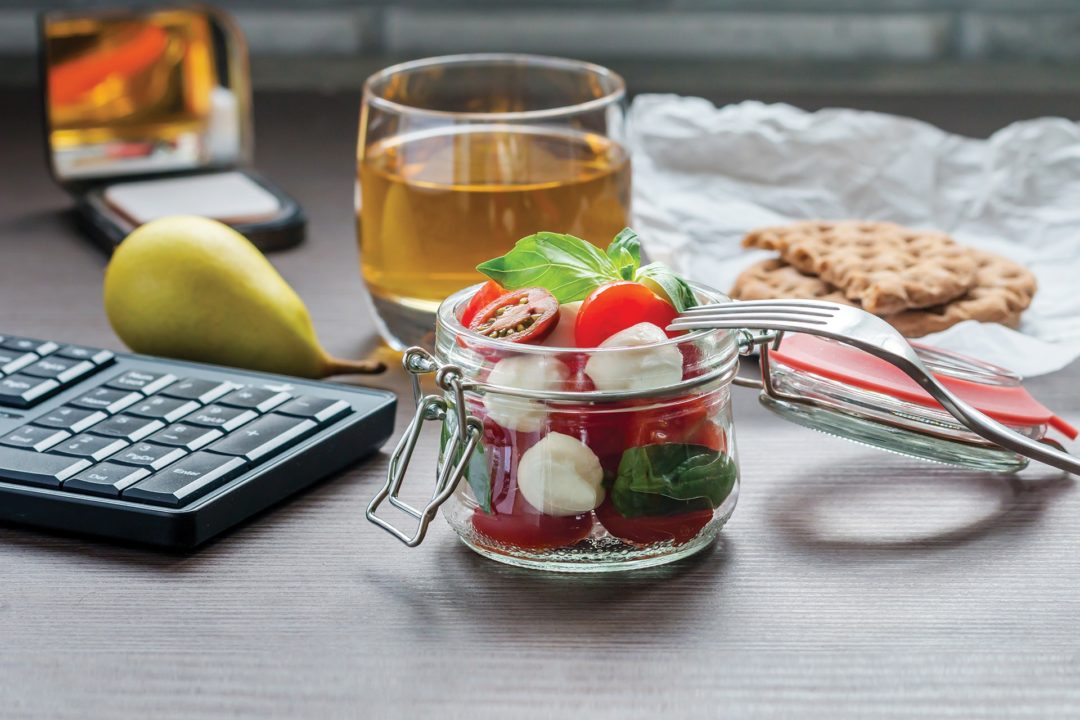Whether having a fun day out or preparing for work or school, packing a healthy snack that is not only flavorful, but portable can at times be tough. With many traditional healthy treats needing to be prepared or required to be refrigerated, the additional work and weight can be quite inconvient. Thankfully, today there are many options that can satisfy everyone’s needs and still fulfill everyone’s cravings.
Crunching DownWhile it may seem hard to believe, an interest in chips as a healthy snack is actually on the rise. According to the report, “How America’s Eating Habits Are Changing,” by the Private Label Manufacturers Association, consumers prefer salty snacks, which include chips, nuts, pretzels, crackers and popcorn. And with a rise in the trend of “better-for-you” and “better choice” snack products, says Eric Van De Wal, vice president of marketing for Clearview Foods, a division of Snyder-Lance, Inc., based in Charlotte, NC, “Consumers are becoming more health-conscious, so snack products made with clean ingredients are highly sought after right now.”
Of course with any new trend, shoppers can expect to find quite a few new brands popping up in their favorite stores. However, how can anyone be sure that their new favorite chips are actually healthy for them? Marc Seguin, chief marketing officer of Popchips, based in Los Angeles, CA, states all “consumers need to do [is] their homework.”
“We work very hard to emphasize the difference between our brand and the competition,” said Seguin. “One very clear way we do this is through our labeling, indicating our product is never fried and always real, non-GMO, no added preservatives, no artificial flavors, no synthetic colors, no cholesterol, zero grams trans fat and are certified gluten-free.”
Like Seguin, John Honeck, chief commercial officer of Beanfields, Los Angeles, CA, believes with one look at the nutritional and ingredient list and shoppers will instantly know the difference.
“The base of our chips [is] made with two simple ingredients: beans and rice. Our chips are [also] packed with protein and fiber, and have less fat than traditional potato chips and corn-based tortilla chips.”
New flavors and flavor combinations are also becoming a top priority.
“We offer consumers what they want — the flavors they love with better-for-you attributes,” said Honeck. An example of this is the companies barbecue flavor, which is made “with just the right amount of sweet and smoky goodness,” but with “zero grams of sugar,” states Honeck.
Van De Wal believes that it is also important to reinvent a company’s signature product each year with fresh and innovative flavors, but if for example, a limited edition offering such as the company’s Bacon Habanero Pretzel Crisps, becomes extremely popular companies should follow their shopper’s demands and “keep it on retailer shelves.”
A Quick ChewWith 91% of adults snacking at least once a day and 71% aiming for a treat that adds more protein to their diet, a “protein bar with real whole food ingredients,” states Peter Rahal, CEO and co-founder of RXBar, based in Chicago, IL, “[would] make a great on-the-go breakfast, pre/post-workout fuel, or just a filling snack on the go.”
The protein-filled snack may also appeal to shoppers on a lifestyle diet, such as Paleo. However, don’t expect every company to follow a specific diet trend.
“Instead of focusing on trends when innovating new products, we seek to meet needs consumers might not know they have,” says Stephanie Perruzza, MS, RD, CDN and health and wellness communications specialist at KIND, New York City, NY. “Rather than focus on what’s not in our snacks, such as less calories or less fats, we like to focus on what is in our snacks, such as nutrient-dense nuts full of hearty fats.”
As for where the snack bar may be in a few years, Rahal sees shoppers becoming “more aware of intensity sweeteners and wanting foods with less sweetness.”
Like Rahal, Perruzza also sees consumers becoming aware of their sugar intake. “We’re excited for the new Nutrition Facts Panel changes that are underway, especially the mandatory listing of added sugars,” says Perruzza. “This disclosure will allow consumers to differentiate naturally-occurring sugars and those that are added so they can understand how to stay below the established daily limit for added sugars, which is 50 grams.”
One great example of how snack bars are truly standing out to shoppers is the focus and embrace of transparency and clean ingredients.
“We put our core ingredients on the front of the packaging so people know what they’re eating, said Perruzza. “We use real, whole ingredients in our bars to offer a protein bar that is filling and tastes amazing.”
Sweet and FulfillingIf you’ve only associated cookies as being a sweet treat, then it’s time to start thinking differently. What was once considered a high in sugar and fat snack, has now been transformed into a positive contributor to one’s daily nutrient needs.
And while classic flavors such as oatmeal, chocolate chip and peanut butter will remain a constant when choosing a flavor, Joel Warady, chief sales and marketing officer of Enjoy Life Foods, based in Chicago, IL, believes “globally-inspired cuisines and flavor profiles” will begin to drive the market, due to “millennials who have more adventurous palates and want more unique flavors to spice up their everyday snacking.”
To ensure consumers are not fooled by labels with marketing buzzwords, which are not regulated, such as “healthy,” Warady suggests shoppers should start asking themselves important questions like, “Do I recognize these ingredients?” and “Can I pronounce them?” “If the answer is no, then you may have an unhealthy snack on your hands,” says Warady. “[Instead] look for shorter ingredients lists, low sugar and sodium, no artificial preservatives and no protein isolates.”
As for how cookies could possibly be classified as a health factor, one way is with the addition of protein.
“Some may not need additional protein in their diets, but there are many who do or who are looking for innovative ways to get their protein in, said Peggy O’Shea Kochenbach, RDN, LDN, Whey2Be!, a product of Action Brand Management, based in Boca Raton, FL. “ Research shows that eating adequate amounts of protein plays a role in promoting satiety — keeping you satisfied longer — and also helps to preserve lean muscle mass and overall nutrient balance. Once more of a niche focus for athletes, the perceived health benefit of protein has broadened and today consumers across many demographic groups are looking for new and interesting ways to boost their protein intake.”
Warady states shoppers can also start to look forward to “foods free-from the top eight allergies — identified as milk, eggs, fish, crustacean selfish, tree nuts, peanuts, wheat and soy” as the cookie category continue to “grow [and] as food allergies become more prevalent.
ReformulatedBesides the usual snacking options, shoppers are also looking towards classic options, such as fruit, but with an exciting twist. “One of the biggest advantages of eating freeze-dried [fruit and vegetable] products is the nutrient retention,” said Jessica Bartels, marketing manager at Crunchies Natural Food, based in Westlake Village, CA. “Compared to dehydrated fruits, Crunchies retains the majority of the nutrients found in fresh fruit. [The] high nutritional value combined with convenience makes Crunchies a simple way to have a healthy snack at home or on-the-go.” Notably, savory and spicy flavors, “such as sriracha, curry, chipotle, ginger, and turmeric are becoming mainstream,” states Megan Cleveland, R&D/QA manager of Crunchies.
To tap into shoppers’ wants and needs for transparency, Bartels believes many companies, like her own, may start driving the market with food traceability concepts in order to win not only consumers but also retailers.
“Consumers want to know more about where their products are coming from and how they are being produced,” says Bartels. “We have recently launched a new traceability platform on our website where the consumer can find their fruit’s roots. They are able to type in the 5 digit traceability code found on the back of their package, which then generates where in the world their bag of Crunchies freeze-dried snacks were grown.” Bartels believes this is an effective way to engage customers and crucial to remain competitive. “Snack brands should be seeking new ways to simplify their sourcing and manufacturing practices in order to join the traceability movement.”
No longer just a convenience store grab and go item, beef and turkey jerky is another classic option that has been reformulated and has even become a new snacking favorite. “The majority of meat snacks still use sodium nitrite as a preservative, but we do not,” says Ching Lee, CEO of Little Red Dot Kitchen, maker of Singapore and Malaysian street-style roasted meat snacks, Bak Kwa, based in Sunnyvale, CA. “All of our Bak Kwa are lower than 190 mg of sodium because we don’t use either nitrates or nitrites. Our Bak Kwa meat snacks are produced from protein sources raised humanely and without antibiotics or hormones. The Bak Kwa is minimally processed with most ingredients having non-GMO verification. They are also free from artificial ingredients, wheat, dairy and eggs.”
In order to differentiate itself from other companies, Little Red Kitchen focuses on the meat or protein, that provides the body with complete amino acids, which are an energy source for the body. In addition the company believes “food and ingredients closer to their original forms are always better,” says Lee. “That means we think soy that is not genetically modified is a better choice and cane sugar is always preferred over high fructose corn syrup, which we have never used. A lot of ingredients in our Bak Kwa are already non-GMO including the feed for the animals we use, and we continue to source spices and ingredients that have non-GMO verification.”
An old snacking standby, bread, is also getting a facelift. Eat the Ball, based in El Segundo, CA, is utilizing an innovative production process called pro.ferment.iced which gently ferments and freezes the bread in a way that preserves vitamins and minerals usually lost and also allows for better shelf life. According to the firm’s website, its Multigrain variety provides up to 20% of one’s recommended daily value of vitamins B1, B6, and B9. Sandwiches are an important part of America’s on-the-go snacking repertoire. However, it can be a bit labor intensive, which is why Eat the Ball also makes “boosted” versions of their breads stuffed with nut and nougat cream and most recently, peanut butter and jelly. “These mini sandwiches are great as snacks for busy on-the-go shoppers that can also be included in kids’ lunches,” says Joe Carter, managing director of the firm. Indeed, besides taste, the products’ sports ball shapes make for a fun snack for children.
Snacking is no longer an unhealthy indulgence, but a great way to conveniently get nutrients throughout the day.WF
Published in WholeFoods Magazine June 2017









